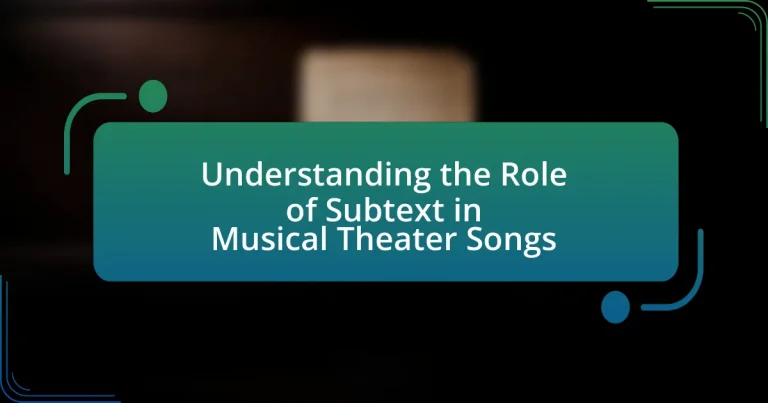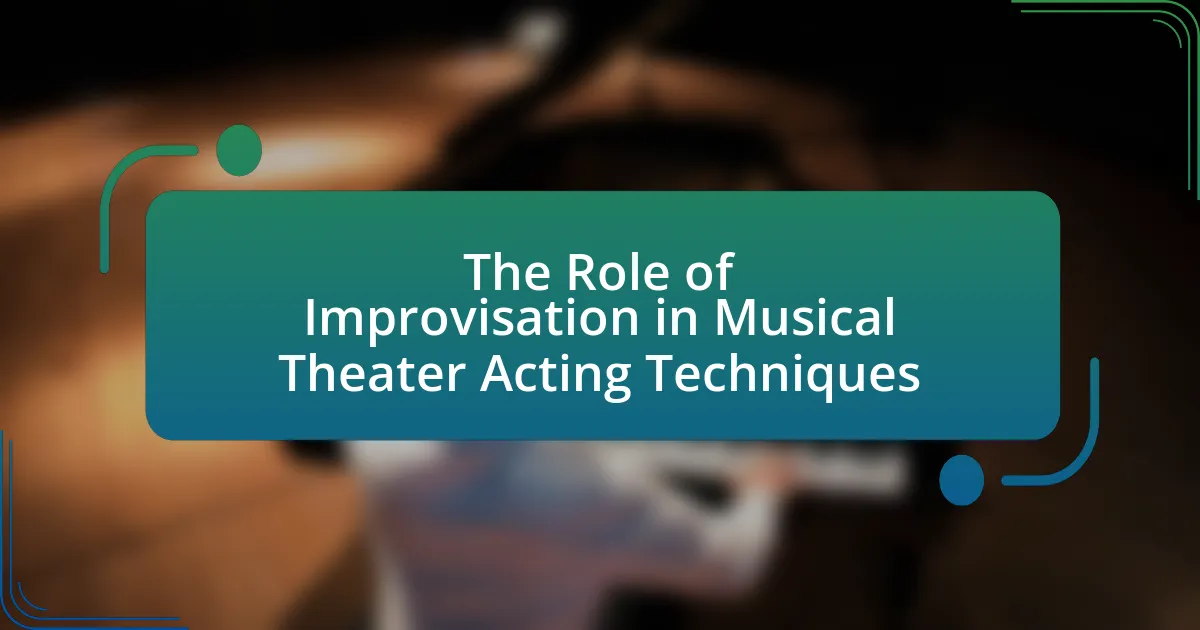The article focuses on the role of subtext in musical theater songs, emphasizing its importance in conveying deeper emotional truths and character motivations that are not explicitly stated in the lyrics. It explores how subtext enhances storytelling by adding complexity to characters’ emotions and motivations, allowing audiences to engage more fully with the narrative. Key elements contributing to subtext include lyrical ambiguity, emotional contrast, and contextual framing. The article also discusses techniques for performers and composers to effectively convey subtext, as well as the impact of cultural context on understanding these underlying meanings. Additionally, it highlights various types of subtext, such as emotional and narrative subtext, and provides examples from well-known musicals to illustrate these concepts.
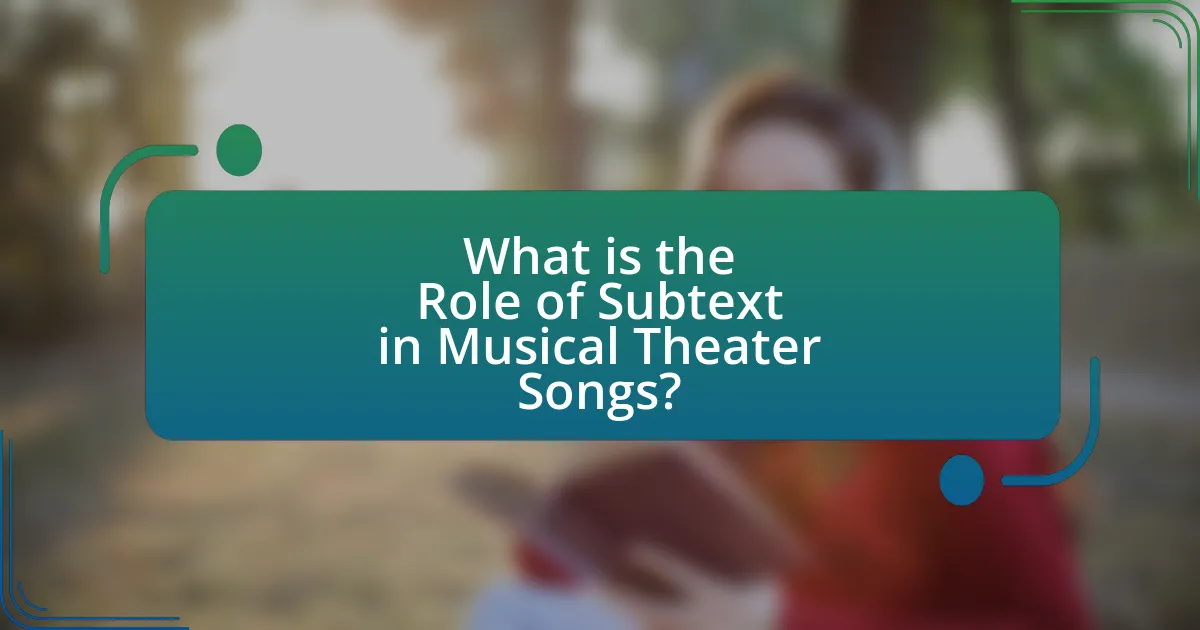
What is the Role of Subtext in Musical Theater Songs?
Subtext in musical theater songs serves to convey deeper emotional truths and character motivations that are not explicitly stated in the lyrics. This layer of meaning allows audiences to connect with the characters on a more profound level, as the subtext often reveals their inner conflicts, desires, and fears. For instance, in “I Am What I Am” from La Cage aux Folles, the character’s assertive declaration of identity is underscored by a subtext of vulnerability and societal rejection, enhancing the emotional impact of the performance. This use of subtext enriches the storytelling by adding complexity and nuance, making the songs resonate more deeply with the audience.
How does subtext enhance the storytelling in musical theater?
Subtext enhances storytelling in musical theater by adding depth and complexity to characters’ emotions and motivations. This layer of meaning allows audiences to engage more fully with the narrative, as they interpret the underlying messages conveyed through dialogue and song. For instance, in “West Side Story,” the song “Something’s Coming” expresses hope and anticipation, but the subtext reveals deeper themes of longing and societal barriers faced by the characters. This interplay between text and subtext creates a richer experience, encouraging viewers to explore the nuances of the story beyond the surface level.
What are the key elements that contribute to subtext in songs?
Key elements that contribute to subtext in songs include lyrical ambiguity, emotional contrast, and contextual framing. Lyrical ambiguity allows for multiple interpretations, enabling listeners to derive personal meanings from the words. Emotional contrast, where the music or delivery conveys a different feeling than the lyrics, creates a deeper layer of meaning. Contextual framing, which involves the situational background of the song within the narrative, enhances the subtext by providing additional layers of understanding. These elements work together to enrich the listener’s experience and engagement with the song’s underlying themes.
How does subtext differ from the literal meaning of lyrics?
Subtext in lyrics refers to the underlying themes, emotions, or messages that are not explicitly stated, while the literal meaning conveys the direct, surface-level interpretation of the words. For example, a song may describe a romantic relationship literally, but the subtext could reveal deeper feelings of longing, regret, or societal critique. This distinction is crucial in musical theater, where characters often express complex emotions through subtext, enriching the narrative and engaging the audience on multiple levels. The effectiveness of subtext is evidenced by its ability to resonate with listeners, allowing them to connect with the emotional depth of the performance beyond the straightforward meaning of the lyrics.
Why is understanding subtext important for performers?
Understanding subtext is crucial for performers because it enhances their ability to convey deeper emotional truths and intentions behind their characters’ words. By grasping the underlying meanings and motivations that are not explicitly stated, performers can create more authentic and nuanced portrayals. This skill allows them to connect with the audience on a more profound level, as subtext often reveals the complexities of human relationships and emotions. Research in theater studies indicates that performances rich in subtext resonate more with audiences, leading to a more engaging and impactful experience.
How can performers convey subtext effectively through their delivery?
Performers can convey subtext effectively through their delivery by utilizing vocal tone, body language, and pacing to imply deeper meanings beyond the spoken words. For instance, a performer may use a softer tone or a hesitant pace to suggest vulnerability, even if the lyrics do not explicitly state it. Research indicates that non-verbal cues, such as facial expressions and gestures, significantly enhance the audience’s perception of subtext, as demonstrated in studies on emotional communication in performance arts. By integrating these elements, performers can create a layered interpretation of their characters, allowing the audience to grasp the underlying emotions and intentions that are not overtly expressed in the text.
What techniques can actors use to interpret subtext in songs?
Actors can use techniques such as emotional analysis, character backstory exploration, and vocal inflection to interpret subtext in songs. Emotional analysis involves identifying the feelings and motivations behind the lyrics, allowing actors to convey deeper meaning. Character backstory exploration helps actors understand the context and circumstances that influence a character’s perspective, enriching their performance. Vocal inflection, including pitch, tone, and rhythm variations, can emphasize specific emotions or intentions, enhancing the subtext conveyed through the song. These techniques are supported by the principles of acting and musical theater, which emphasize the importance of understanding character motivations and emotional depth in performance.
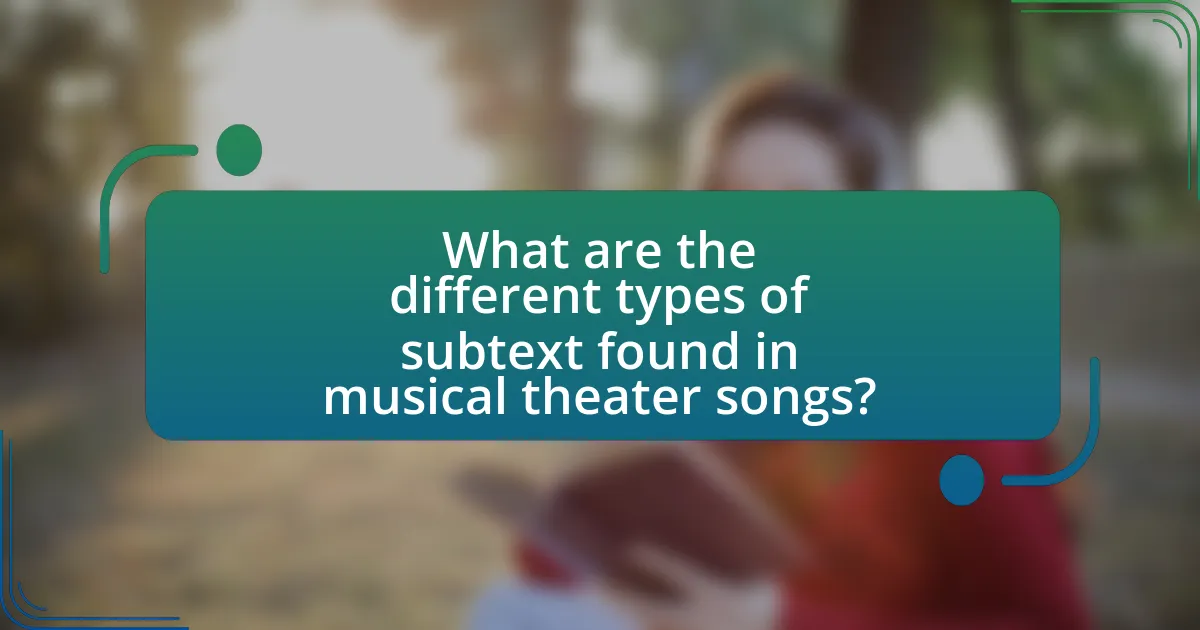
What are the different types of subtext found in musical theater songs?
Different types of subtext found in musical theater songs include emotional subtext, situational subtext, and character subtext. Emotional subtext conveys feelings that characters may not explicitly express, allowing the audience to grasp deeper emotional layers, such as longing or regret. Situational subtext arises from the context of the scene, where the lyrics may hint at underlying tensions or conflicts that are not directly stated, enhancing the narrative. Character subtext reveals the inner thoughts and motivations of characters, often contrasting with their outward expressions, which adds complexity to their portrayal. These types of subtext work together to enrich the storytelling and engage the audience on multiple levels.
How do emotional subtext and narrative subtext differ?
Emotional subtext refers to the underlying feelings and emotions that characters express indirectly, while narrative subtext pertains to the deeper meanings and themes conveyed through the story’s plot and structure. Emotional subtext often reveals a character’s true motivations or conflicts that are not explicitly stated, enhancing the audience’s understanding of their emotional state. In contrast, narrative subtext provides insight into broader themes, societal issues, or character arcs that may not be overtly articulated in the dialogue or action. For example, in a musical, a character’s joyful song may have emotional subtext of hidden sadness, while the overall narrative subtext could explore themes of love and loss.
What examples illustrate emotional subtext in popular musical theater songs?
Examples that illustrate emotional subtext in popular musical theater songs include “I Dreamed a Dream” from Les Misérables and “The Room Where It Happens” from Hamilton. In “I Dreamed a Dream,” the character Fantine expresses deep despair and loss, reflecting her shattered hopes and the harsh realities of her life, which conveys a profound emotional depth beyond the lyrics. Similarly, “The Room Where It Happens” uses political maneuvering as a metaphor for exclusion and power dynamics, revealing the characters’ frustrations and ambitions, thus adding layers of meaning to the seemingly straightforward narrative. These songs demonstrate how emotional subtext enhances the storytelling in musical theater, allowing audiences to connect with the characters on a deeper level.
How does narrative subtext drive the plot in musical theater?
Narrative subtext drives the plot in musical theater by providing deeper emotional layers and motivations that influence character actions and decisions. This underlying meaning often contrasts with the overt dialogue and lyrics, creating tension and complexity in the storyline. For example, in “West Side Story,” the characters’ songs express their desires and fears, while the subtext reveals societal tensions and personal conflicts, propelling the narrative forward. Such subtext enriches the audience’s understanding of character relationships and thematic elements, making the plot more engaging and impactful.
What role does cultural context play in understanding subtext?
Cultural context significantly influences the understanding of subtext by providing the background necessary to interpret underlying meanings in communication. In musical theater songs, cultural references, societal norms, and historical events shape the audience’s perception of the characters’ emotions and intentions. For instance, a song that includes references to specific cultural practices or historical events may resonate differently with audiences familiar with that context compared to those who are not. This is evident in works like “Hamilton,” where the historical context of the American Revolution enriches the subtext of the characters’ struggles and aspirations, allowing audiences to grasp deeper meanings that reflect their own cultural narratives.
How can cultural references enhance or obscure subtext in songs?
Cultural references can enhance or obscure subtext in songs by providing layers of meaning that resonate with specific audiences or by creating ambiguity that may confuse listeners. When a song incorporates cultural references, such as historical events, popular media, or societal norms, it can deepen the emotional impact and relatability of the lyrics, allowing listeners to connect on a personal level. For instance, a song referencing a well-known film can evoke shared memories or feelings associated with that film, enriching the listener’s understanding of the song’s themes. Conversely, if the cultural references are obscure or not widely understood, they can obscure the intended subtext, leading to misinterpretation or disengagement from the audience. This duality illustrates how cultural references serve as both a bridge and a barrier in conveying deeper meanings within musical theater songs.
What are some examples of cultural subtext in well-known musicals?
Cultural subtext in well-known musicals often reflects societal issues, identity, and historical contexts. For instance, “West Side Story” addresses racial tensions and gang violence, paralleling the real-life struggles of immigrant communities in America during the 1950s. Similarly, “Rent” explores themes of LGBTQ+ identity and the impact of the AIDS crisis, highlighting the marginalization of these communities in the late 20th century. Another example is “Hamilton,” which reinterprets American history through the lens of race and immigration, emphasizing the contributions of diverse figures in the founding of the United States. These musicals utilize their narratives and characters to comment on and critique cultural norms and societal challenges, making their subtext significant and relevant.
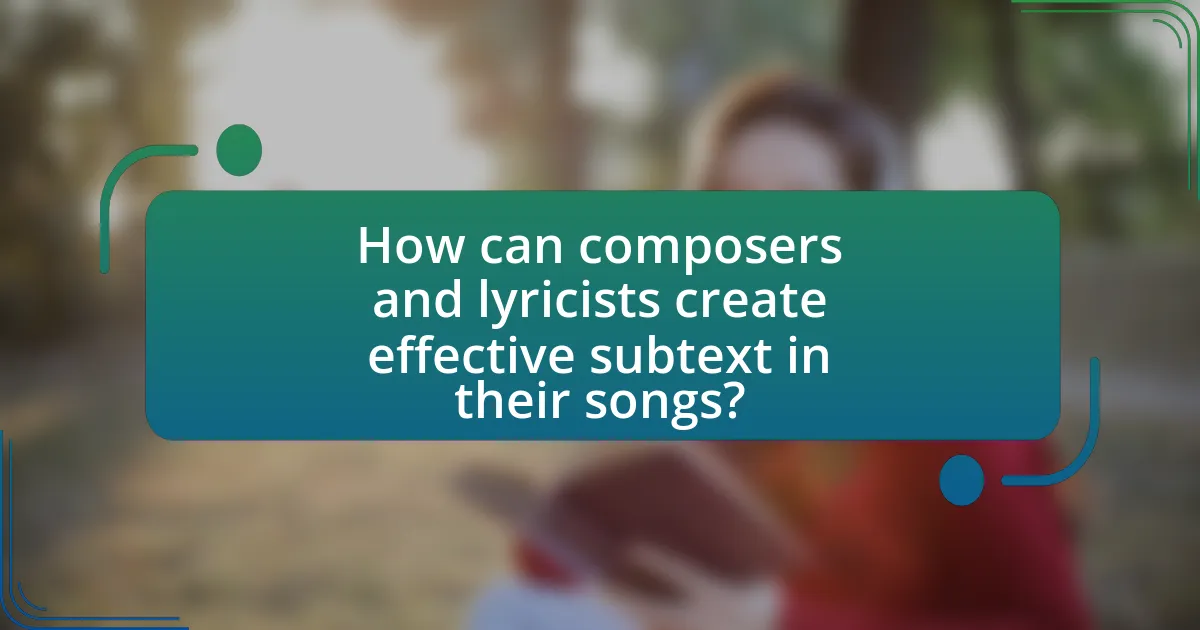
How can composers and lyricists create effective subtext in their songs?
Composers and lyricists can create effective subtext in their songs by using metaphor, imagery, and contrasting emotions to convey deeper meanings beyond the literal lyrics. For instance, employing metaphors allows them to express complex feelings indirectly, while vivid imagery can evoke specific emotions and settings that resonate with the audience. Additionally, contrasting emotions within the lyrics can highlight the tension between what is said and what is felt, enhancing the subtext. This technique is evident in works like Stephen Sondheim’s “Send in the Clowns,” where the lyrics suggest longing and regret through seemingly simple phrases, allowing listeners to interpret the underlying emotions.
What techniques do composers use to embed subtext in music?
Composers embed subtext in music through techniques such as thematic development, harmonic contrast, and lyrical juxtaposition. Thematic development allows composers to introduce motifs that carry emotional weight, which can suggest deeper meanings beyond the surface narrative. Harmonic contrast, where dissonance is used against consonance, can evoke tension or resolution, reflecting the characters’ inner conflicts. Lyrical juxtaposition involves placing contrasting ideas or emotions within the lyrics to highlight subtextual themes, often revealing hidden motivations or societal critiques. These techniques are evident in works like Stephen Sondheim’s “Into the Woods,” where the music intricately supports the complex emotional landscapes of the characters, enhancing the overall narrative depth.
How does melody contribute to the perception of subtext?
Melody significantly contributes to the perception of subtext by conveying emotions and nuances that words alone may not express. In musical theater, melodies can evoke feelings such as longing, joy, or sadness, which enhance the underlying themes of the lyrics. For instance, a minor key melody can suggest melancholy, while a major key may imply happiness, thus shaping the audience’s interpretation of the character’s true feelings or intentions. Research indicates that melodies can influence emotional responses; a study published in the journal “Psychology of Music” by Juslin and Laukka (2003) found that specific melodic contours are associated with distinct emotional expressions. This interplay between melody and subtext allows audiences to grasp deeper meanings in the narrative, enriching their overall experience.
What role do harmonies and rhythms play in conveying subtext?
Harmonies and rhythms play a crucial role in conveying subtext by enhancing emotional depth and character intentions in musical theater songs. Harmonies can create tension or resolution, reflecting a character’s internal conflict or emotional state, while rhythms can influence the pacing and urgency of the narrative. For example, dissonant harmonies often signify unease or turmoil, aligning with a character’s struggle, whereas consonant harmonies can indicate resolution or happiness. Similarly, syncopated rhythms can evoke feelings of excitement or anxiety, effectively communicating subtext that may not be explicitly stated in the lyrics. This interplay between musical elements and emotional expression is essential in enriching the storytelling experience in musical theater.
How can lyricists craft lyrics that support subtext?
Lyricists can craft lyrics that support subtext by using metaphor, imagery, and nuanced language to convey deeper meanings beyond the literal words. For instance, employing metaphors allows lyricists to express complex emotions or themes indirectly, enabling listeners to interpret the underlying message. Additionally, vivid imagery can evoke specific feelings or settings that resonate with the audience, enhancing the emotional impact of the song. A notable example is Stephen Sondheim, who often layers his lyrics with subtext, allowing for multiple interpretations and enriching the narrative of his musical works. This technique not only engages the audience but also invites them to explore the themes on a more profound level, demonstrating the effectiveness of subtext in musical theater.
What strategies can lyricists employ to suggest deeper meanings?
Lyricists can employ metaphor and symbolism to suggest deeper meanings in their songs. By using metaphors, lyricists create connections between seemingly unrelated concepts, allowing listeners to interpret the lyrics on multiple levels. For example, in the song “The Sound of Silence” by Simon & Garfunkel, the imagery of darkness symbolizes ignorance and societal disconnect, prompting listeners to reflect on deeper social issues. Additionally, lyricists can utilize narrative techniques, such as storytelling and character development, to convey complex emotions and themes. In “I Am What I Am” from La Cage aux Folles, the character’s declaration of self-acceptance serves as a powerful statement about identity and resilience, resonating with audiences on a personal level. These strategies enhance the emotional impact of the lyrics and invite listeners to engage with the underlying messages.
How do word choices and phrasing impact the subtext in lyrics?
Word choices and phrasing significantly shape the subtext in lyrics by conveying deeper meanings and emotions beyond the literal interpretation. Specific words can evoke particular feelings or imagery, influencing how listeners perceive the underlying themes. For instance, using words with strong connotations can create a sense of urgency or nostalgia, while the rhythm and structure of phrasing can enhance emotional impact. Research in linguistics shows that language can manipulate audience perception; for example, the use of metaphors and similes in lyrics often invites listeners to draw personal connections, enriching their experience. Thus, the deliberate selection of language in songwriting is crucial for crafting nuanced subtext that resonates with audiences.
What are some best practices for analyzing subtext in musical theater songs?
To analyze subtext in musical theater songs effectively, one should focus on the lyrics, musical composition, and character context. Examining the lyrics reveals underlying emotions and intentions that may not be explicitly stated. The musical composition, including melody and harmony, can enhance or contradict the lyrics, providing additional layers of meaning. Understanding the character’s background and motivations is crucial, as it informs how the subtext is conveyed through performance. For instance, in “I Am What I Am” from “La Cage aux Folles,” the character’s defiance is underscored by both the assertive lyrics and the powerful musical arrangement, illustrating the interplay between text and subtext.
How can performers and directors collaborate to uncover subtext?
Performers and directors can collaborate to uncover subtext by engaging in open discussions about character motivations and emotional layers within the script. This collaboration involves analyzing the text together, where performers share their interpretations and directors provide insights on the overall vision, ensuring alignment on the subtextual elements. Research indicates that effective communication between performers and directors enhances the depth of character portrayal, as seen in productions like “Hamilton,” where the creative team worked closely to explore the historical and emotional subtext of the characters. This collaborative process allows for a richer understanding of the material, ultimately leading to a more nuanced performance.
What resources are available for studying subtext in musical theater?
Resources available for studying subtext in musical theater include academic texts, online courses, and scholarly articles. Notable academic texts such as “The Musical Theater Writer’s Survival Guide” by Jeffrey Sweet provide insights into the nuances of subtext in song lyrics and dialogue. Online platforms like Coursera and MasterClass offer courses specifically focused on musical theater, often addressing the importance of subtext in performance. Additionally, scholarly articles in journals like “Theatre Journal” and “Studies in Musical Theatre” analyze various aspects of subtext, providing critical perspectives and case studies that enhance understanding. These resources collectively contribute to a comprehensive study of subtext in musical theater.
